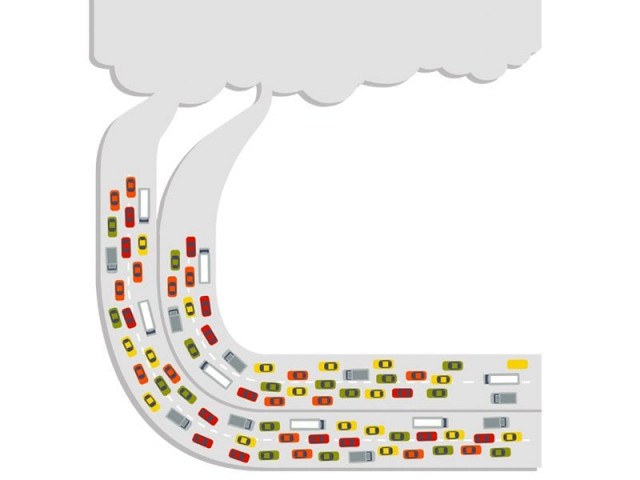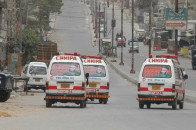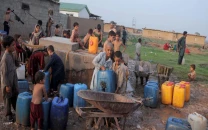Unanimous: Twin cities air unsafe to breathe
Rawalpindi had higher levels of NO2 and O3 than Islamabad, according to the FJWU study.

Study of 135 locations fail WHO standards; poorly maintained vehicles, traffic mess and unplanned construction to blame. DESIGN: ANUSHAY FURQAN
The federal capital’s air quality might be slightly better than its (un)twin garrison city’s, but both cross the international limits for an air pollutant, says a research report.
Researchers at Fatima Jinnah Women University (FJWU) monitored the concentration of nitrogen dioxide (NO2) — a toxic gas that decreases lung function and leads to the formation of other air pollutants — in the twin cities from November 2009 to March 2011.
They found the NO2 level to be higher than the World Health Organisation (WHO) permissible limit of 21 parts per billion (ppb), averaged over a year, at each of the 135 sites in Rawalpindi and Islamabad where air was sampled.
The research — conducted by FJWU Assistant Professor Dr Sheikh Saeed Ahmad and Neelam Aziz — also measured ground-level ozone (O3), whose concentration levels were found to be below WHO safety standard for O3. It was published in December 2012 in the peer-reviewed scientific journal Environmental Monitoring and Assessment under the title “Spatial and temporal analysis of ground level Ozone and nitrogen dioxide concentration across the twin cities of Pakistan.”

The results show that concentration levels of NO2 and O3 were high in areas of intense traffic flow and congestion in both cities. These areas included dual carriageways, sub-roads, major roads, commercial areas, old residential areas and areas with educational institutions.
“The results were expected because of the traffic congestion,” Dr Ahmad told The Express Tribune.
Traffic congestion provides a precursor to the increase in NO2 levels because the gas is mostly produced by internal combustion engines, said Dr Muhammad Fahim Khokhar, an assistant professor at the National University of Sciences and Technology’s Institute of Environmental Sciences and Engineering. A car engine is an example of internal combustion engine.
Unsurprisingly, the highest concentrations of NO2 and O3 were observed on dual carriageways and bus stops.
The study listed the increase in the number of vehicles on the road, increased population, and fuel-inefficient vehicles as possible causes of the increased concentration.

Khokhar said an NO2 sampling study he conducted in the twin cities in November 2012 corroborates Ahmad and Aziz’s findings.
Pakistan-Environment Protection Agency (Pak-EPA) Director General Asif Shuja said the agency’s own measurements also pointed out high localised concentrations of NO2 in dense commercial areas in Islamabad such as Aabpara.
But Shuja said the overall ambient air quality — measured by the Pak-EPA through a single air quality station in Islamabad — is within the permissible WHO limit. The ambient air quality considers an overall mix of several major air pollutants.
Rawalpindi had higher levels of NO2 and O3 than Islamabad, according to the FJWU study.
This could be due to the narrower roads, enclosing architecture of the road network and higher building congestion in Rawalpindi, the study said.
District environment officials in Rawalpindi said they are trying to curb harmful vehicular emissions by banning 2-stroke rickshaws and performing biannual smoke emission checks on motor vehicles.

But the checks are only for commercial vehicles — taxis, passenger vans, buses and trucks. Private vehicles in the twin cities, which have increased in number over the past few years, are not considered.
“Every person is bringing a car on the road,” Ahmad said. “If there are three adults in a house, they will often have three separate cars.”
The number of registered vehicles in Islamabad grew by about 33 per cent every year from 2008 to 2012. Car pooling and an efficient public transport system that would reduce the traffic load in the cities are ideal for NO2 reduction, Ahmad said.
Another issue is that post-18th Amendment, Pak-EPA’s domain is limited to the federal capital.
At the same time, regional or district-level environment units are short-staffed and cannot enforce environmental regulations on multiple fronts such as air, solid waste and water pollution.
Why are NO2 and O3 bad?
The effects of NO2 and O3 are not immediate; rather it is the long-term exposure to high concentration levels of these gases that could impact public health.
Ahmad and Aziz also mapped the concentration levels of the gases so further studies could be done to determine the health impact on people in the areas where air pollution is higher.
Ahmad hopes the FJWU study could lead to some good.
“This research provides a baseline study identifying hot spots for poor air quality, so that policymakers can at least try to bring the precursor rate down,” Ahmad said.
Murree Road and Airport Road were identified as two areas most vulnerable to higher concentrations of NO2 and O3 in the research.
NO2 is dangerous because it can react with volatile organic compounds (VOCs) in the air to create secondary air pollutants including ground-level ozone.
Ground-level ozone should not be confused with the “good” ozone layer protecting the Earth from the sun’s ultraviolet rays.
It is “bad” because it is a constituent of photochemical smog — a form of air pollution often associated with urban and industrial areas — that can lead to respiratory diseases.
Police powers limited by logistics
In both Islamabad and Rawalpindi, traffic police officials said they impose fines for cars producing excessive pollution. But fines are mostly issued on the basis of cars emitting visible black carbon smoke and enforcement is not consistent.
In the federal capital, for example, the smoke emission fines are also dependant on one smoke detection unit which is owned by the environment ministry and the use of which requires coordination between the police and the ministry. The smoke emission fines are issued in the “other” category and hit the pocket for Rs300.
Published in The Express Tribune, February 12th, 2013.


















COMMENTS
Comments are moderated and generally will be posted if they are on-topic and not abusive.
For more information, please see our Comments FAQ